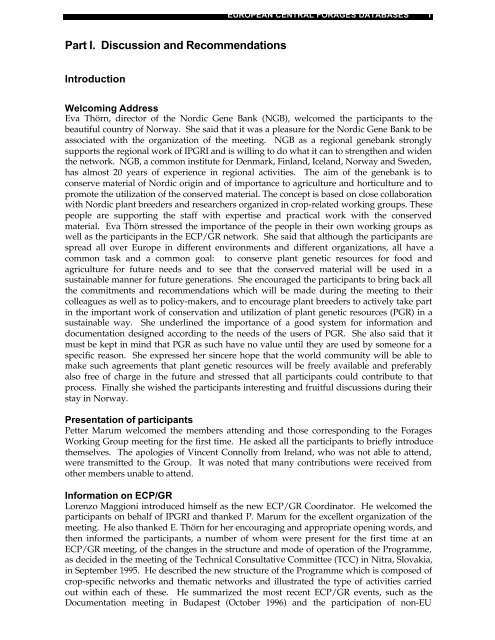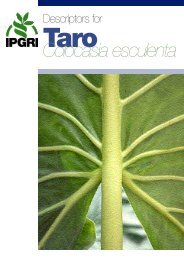Download PDF (6215 kb) - Bioversity International
Download PDF (6215 kb) - Bioversity International
Download PDF (6215 kb) - Bioversity International
Create successful ePaper yourself
Turn your PDF publications into a flip-book with our unique Google optimized e-Paper software.
Part I. Discussion and Recommendations<br />
Introduction<br />
EUROPEAN CENTRAL FORAGES DATABASES 1<br />
Welcoming Address<br />
Eva Thörn, director of the Nordic Gene Bank (NGB), welcomed the participants to the<br />
beautiful country of Norway. She said that it was a pleasure for the Nordic Gene Bank to be<br />
associated with the organization of the meeting. NGB as a regional genebank strongly<br />
supports the regional work of IPGRI and is willing to do what it can to strengthen and widen<br />
the network. NGB, a common institute for Denmark, Finland, Iceland, Norway and Sweden,<br />
has almost 20 years of experience in regional activities. The aim of the genebank is to<br />
conserve material of Nordic origin and of importance to agriculture and horticulture and to<br />
promote the utilization of the conserved material. The concept is based on close collaboration<br />
with Nordic plant breeders and researchers organized in crop-related working groups. These<br />
people are supporting the staff with expertise and practical work with the conserved<br />
material. Eva Thörn stressed the importance of the people in their own working groups as<br />
well as the participants in the ECP/GR network. She said that although the participants are<br />
spread all over Europe in different environments and different organizations, all have a<br />
common task and a common goal: to conserve plant genetic resources for food and<br />
agriculture for future needs and to see that the conserved material will be used in a<br />
sustainable manner for future generations. She encouraged the participants to bring back all<br />
the commitments and recommendations which will be made during the meeting to their<br />
colleagues as well as to policy-makers, and to encourage plant breeders to actively take part<br />
in the important work of conservation and utilization of plant genetic resources (PGR) in a<br />
sustainable way. She underlined the importance of a good system for information and<br />
documentation designed according to the needs of the users of PGR. She also said that it<br />
must be kept in mind that PGR as such have no value until they are used by someone for a<br />
specific reason. She expressed her sincere hope that the world community will be able to<br />
make such agreements that plant genetic resources will be freely available and preferably<br />
also free of charge in the future and stressed that all participants could contribute to that<br />
process. Finally she wished the participants interesting and fruitful discussions during their<br />
stay in Norway.<br />
Presentation of participants<br />
Petter Marum welcomed the members attending and those corresponding to the Forages<br />
Working Group meeting for the first time. He asked all the participants to briefly introduce<br />
themselves. The apologies of Vincent Connolly from Ireland, who was not able to attend,<br />
were transmitted to the Group. It was noted that many contributions were received from<br />
other members unable to attend.<br />
Information on ECP/GR<br />
Lorenzo Maggioni introduced himself as the new ECP/GR Coordinator. He welcomed the<br />
participants on behalf of IPGRI and thanked P. Marum for the excellent organization of the<br />
meeting. He also thanked E. Thörn for her encouraging and appropriate opening words, and<br />
then informed the participants, a number of whom were present for the first time at an<br />
ECP/GR meeting, of the changes in the structure and mode of operation of the Programme,<br />
as decided in the meeting of the Technical Consultative Committee (TCC) in Nitra, Slovakia,<br />
in September 1995. He described the new structure of the Programme which is composed of<br />
crop-specific networks and thematic networks and illustrated the type of activities carried<br />
out within each of these. He summarized the most recent ECP/GR events, such as the<br />
Documentation meeting in Budapest (October 1996) and the participation of non-EU




